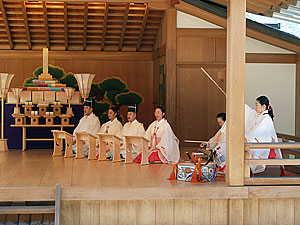Israel, Palestine and the Power of Poetry
Oomoto believes small efforts can have lasting ripple effects on people and peace
By Bill Roberts
Bill Roberts, author of “A Portrait of Oomoto,” gave the following speech at Oomoto’s Tsukushi branch in Kokura, Kyushu, on Sept. 9, 2007.
I am delighted to attend the Tsukushi branch tsukinamisai.
I have visited more than 20 Oomoto branches since 2001. The purpose of many of these visits was to do research for my book, “A Portrait of Oomoto,” published by Tenseisha Press last year.
I was asked to talk about the Middle East because I have some background in the area. Specifically, I would like to talk about the Israeli-Palestinian conflict, and how even small efforts to help the two sides reconcile can be powerful.
Some parts of my book are about the Middle East, so let me first tell you how I ended up writing a book about Oomoto.
For two decades I was an editor at newspapers and magazines. In the mid-1990s I decided to become a freelance writer. In retrospect this move was important because it would give me the flexibility to spend the necessary time at Oomoto to write a book.
When I am not at Oomoto I live in San Jose, California, and write about the electronics industry. San Jose is also known as Silicon Valley because it is the birthplace of the semiconductor industry. It is 90 kilometers south of San Francisco.
Onisaburo’s yowan brought me to Japan the first time. I was working with a ceramics teacher in California who had attended Oomoto’s traditional arts seminar. Her name is Coeleen Kiebert.
In 1998, several months after I started to work with her, Coeleen announced she would take a group to Oomoto the following year.
She told us about Onisaburo and showed photos of his tea bowls.
I knew nothing about tea bowls, tea ceremony or Oomoto. But I was captivated by those tea bowls. I wanted to see them for myself, and to learn about the man who had made them.
“Made in Japan“
When I first visited Oomoto I was nearly 50 years old, but Japan had always been a part of me. My parents met in Japan. My father was an Army officer and my mother was a civilian secretary in the occupation. They were married in Tokyo in 1947.
I was their first child, born in the United States in 1950. However, I was conceived in April 1949 three months before they left Japan. So I was literally “made in Japan,” like the transistor radios that began to appear in the U.S. in the 1950s.
My first trip to Japan, in April 1999, took place exactly 50 years after I was conceived here. By the end of that visit I was smitten with Japan. I returned to Oomoto with Coeleen in 2000 and 2001.
Then the Oomoto International Department invited me to work on several editorial projects. I came for three months at the end of 2001 and returned each year after as a volunteer writer.
On each visit I wrote material for the English web site, some of which has been translated into Japanese. This all led to the book.
The arts first brought me to Oomoto, but I came to see that Oomoto stands for much more. On my first extended stay in late 2001 I learned about Bankyo Dokon and the importance of Israel.
These matters became even clearer in 2003, when I came to photograph and write about the Ayabe Project, which brought Palestinian and Israeli youth to Japan for a week.
Changing one person at a time
The Ayabe Project is a good example of Oomoto’s thinking about resolving conflicts like the one between Israel and Palestine. You believe you can have an impact through the ripple effects caused by your prayer, interfaith dialogue, arts and other actions, even if you only change the world one person at a time.
This is a powerful idea, maybe more powerful than any grand diplomatic ideas because peace will not come until each individual respects all others regardless of religious or cultural differences.
When all the wars are over and the treaties are signed, individual people will still have to learn to communicate and cooperate together. This is especially true for Palestinians and Israelis.
In my book, there is a chapter about the importance of Israel to Oomoto. I ended the chapter with the following story.
One day in the summer of 2005, when I was at Oomoto writing the book, someone in the International Department asked me to help translate a tanka the Spiritual Leader had written for that summer’s poetry festival (utamatsuri).
She wanted her poem sung in Japanese, Esperanto and English. I was handed a rough draft in English and asked to polish it.
A few weeks later, the poem was sung in three languages at the utamatsuri. Here is the poem:
My wish is to see / A poetry festival / In Esperanto / With all our fellow brothers / In sacred Jerusalem
I thought: Peace through poetry. What an idea! An utamatsuri in Jerusalem could send out important ripples. You never know.
This poem is powerful because it contains three ideas essential to Oomoto: Jerusalem and Esperanto are explicit; peace is implied.
As you know, Onisaburo Deguchi devoted a volume of Reikai Monogatari to Jerusalem, explaining how it fit into God’s plan to reconstruct the world.
Onisaburo never visited Jerusalem, but if he had completed his expedition to Mongolia, he intended to continue to Jerusalem.
There is no evidence that he planned to put on an utamatsuri, but he did bring costumes for the Noh drama “Seiobo,” which he intended to perform in Jerusalem.
In the year 2000, more than 75 years after Onisaburo’s trip to Mongolia, Ayabe and Jerusalem signed a declaration of friendship with help from Oomoto. This led to the Ayabe Project.
Encounters with Israel
When I heard about the Ayabe Project, I was thrilled because Israel has been important in my life and the conflict there pains me.
I spent the 1971-72 school year at the Hebrew University in Jerusalem studying Middle East politics. Later, during much of my newspaper career, I specialized in the Middle East. But it is more accurate to say my encounter with Israel began a decade earlier.
I was 8 years old when my father’s Army career took us to Europe for three years. We lived in France and Germany. In 1960, we visited Dachau, one of the World War II concentration camps in Germany.
It is not possible to understand the Israeli-Palestinian conflict without understanding the Holocaust, which is why I say my encounter with Israel really began on the day we visited Dachau.
At Dachau, the Nazis imprisoned Jews, some Catholics, Gypsies, Soviet prisoners of war, political prisoners, resistance fighters, and anyone else they wanted to get rid of – especially Jews.
At first Dachau was used for forced labor. Later, when the Nazis began the mass killing of Jews, Dachau became one of many extermination sites.
Dachau is now a memorial and museum. They preserved one of the buildings where prisoners were gassed to death. Some of the ovens where bodies were cremated were also preserved.
At the age of 10, I came face to face with the horror of genocide, and began to understand the reason Jews fought to start their own nation in 1948 and continue to fight today.
European Christians had been persecuting and killing Jews for 1,000 years before the Holocaust. Hitler’s attempted genocide was just the most extensive and effective effort to wipe them out.
For nearly 100 years before the Holocaust, European Jews had worked to secure a homeland in their ancestral home in Palestine, which they call Eretz Israel—Land of Israel. Palestine was part of the Ottoman Empire for five hundred years before World War I, and after that was occupied by Britain until 1948.
In the 50 years before the Holocaust, small numbers of European Jews moved to Palestine. They bought land, created communal farms, and tried to live in peace with the indigenous Arabs.
The communal farm is called a kibbutz. During my year in Israel I spent about six weeks on two school breaks working on a kibbutz on the Lebanese border in northern Israel. I got an appreciation of the idealism that led to the creation of modern Israel.
After World War II, European Jews who survived the Holocaust began to move to Palestine in large numbers, believing that they could only be safe in a nation of their own. Who could argue with that: Six million of them were murdered by the Nazis.
After the world learned how Hitler had murdered Jews, there was widespread support for the creation of a Jewish nation. The United Nations voted to partition Palestine into two states after the British left: One Jewish and one Arab, but Arabs rejected this.
When Jews in Palestine declared independence for modern Israel in 1948, most nations, including the post-war powers, recognized the infant state. Arab nations declared war on the new state.
The time I studied in Israel was one of the most peaceful periods in Israel’s history. As an example: I rode my bicycle through towns and villages all over the West Bank, something you probably would not do today.
In Israel I also had more encounters with the Holocaust. I visited Yad Vashem, the Holocaust memorial in Jerusalem. Yad Vashem means “the hand of God” in Hebrew.
I saw many Holocaust survivors. You could tell who they were from the concentration camp numbers tattooed on their wrists.
Seeing these tattoos did not affect me until I met my Israeli roommate’s mother. She was a camp survivor; the first time I saw her tattoo I felt sick at my stomach and nearly burst into tears.
As a result of my encounters with the Holocaust and with Israel, I came to understand the Israelis and had compassion for their cause.
Encounters with Palestine
The trouble is the founding of Israel displaced many Arabs whose families had lived in Palestine for a very long time. As is so often the case, the solution to one problem created a new problem.
That new problem intensified when Israel captured more land in the 1967 war. There are many issues to be resolved in the conflict, but the main issue is the land Israel has held for 40 years now.
I admit that I had a one-sided view after I left Israel in 1972. I identified with the Israelis and got caught up in their idealism. I’m not Jewish, but I could understand how these people felt.
I eventually came to have similar compassion for Palestinians.
There was a time when Arabs living in what is now Israel were not even called “Palestinians.” They were just called Arabs. I don’t recall hearing the term “Palestinians” at all when I lived there.
These were people without a national identity. It is fair to say that before 1948, the Jews had a national identity but no land, and the Palestinian Arabs had land but no national identity. It did not help that the Arabs had been fighting among themselves for years.
After the 1967 war, militants began to hijack planes and commit other violent acts in the name of the “Palestinian people.” This attempt to create an identity slowly started to work, but that identity was not positive in most of the world.
Much of the world called these militants “terrorists;” but Arabs saw them as freedom fighters. In the newspaper business we used to say: One man’s terrorist is another man’s freedom fighter.
I became immersed in the Palestinian issue when I was the foreign editor for several years in the 1980s at the Detroit Free Press, one of the largest newspapers in America.
Starting in the early 20th century, immigrants from around the world came to work in Detroit’s auto plants. This included a steady stream of immigrants from across the Middle East. The flow from Palestine to Detroit increased after each Middle East war.
Today, a section of Detroit is dominated by Palestinian culture, with several mosques and many coffee shops and social clubs named for West Bank towns.
Detroit also has a large Jewish population. So the Detroit Free Press paid a lot of attention to the Middle East, regularly sending our own reporters and photographers there.
I supervised daily coverage and edited several special reports to help readers understand the conflict. The first of these special reports, published in 1982, explained who “Palestinians” are and examined their claim to nationhood.
Our coverage represented all points of view in the conflict. One day Jews would criticize a story, and Arabs would praise it. The next day Arabs would criticize and Jews would praise. It was impossible to satisfy both groups.
I became well acquainted with Detroit’s Palestinian community. I met with many community leaders. And I spent hours on the phone and in outreach meetings listening to comments about our coverage, from both Palestinians and Jews.
I became sympathetic to Palestinian claims to statehood without changing my view that the Jews deserved their country. It is essential that we embrace the legitimacy of both sides.
Over the decades both sides have committed atrocities against the other and made mistakes. What’s important now is there must be two nations and they must learn to live in peace. Jerusalem is a holy city for three religions, and a way must be found to share it.
Oomoto’s commitment to Middle East peace
In recent decades, Oomoto has had many exchanges with Israelis and Arabs, including Palestinians. You invited leaders from all Middle East religions to attend interfaith prayer and other events.
Wisely, you have remained politically neutral. You keep cordial relations with both sides so you can continue the interfaith work.
Besides inviting Jewish and Muslim religious leaders, you have invited ambassadors from these nations. This year alone you have hosted the ambassadors to Japan from Egypt, Jordan and Israel.
Yasumi Hirose was behind the effort to extend invitations beyond religious leaders to ambassadors. Because of Onisaburo Deguchi’s emphasis on Israel, Hirose believed Oomoto must make an effort – however small -- to encourage Middle East peace.
When I interviewed him for my book, Hirose remembered with delight his two trips to Mount Sinai to participate in interfaith services in 1979 and 1984. The Sinai was occupied by Israel after the 1967 war, and later returned to Egypt under a peace treaty.
I climbed Mount Sinai with a group of students in 1971, when it was still held by Israel. There are two chapels on top. In one we met an old woman, probably a European but she did not say.
She had been on the mountain 30 days and planned to stay another 30. The monks from the Greek Orthodox monastery at the base of Sinai brought her food and water once a week.
She told us she was praying for world peace. She had prayed for peace in other remote places and this was her second time on Mount Sinai. Like Oomoto, she believed in the power of prayer.
Oomoto followers have made many trips to the Middle East, including Israel, Turkey, Egypt, Syria and Saudi Arabia.
And in 2003, you supported the Ayabe Project. Ayabe brought seven Israeli and seven Palestinian teenagers to Japan for a week. Each had lost a family member in the conflict.
The project was initiated by the City of Ayabe and was financed mostly by donations from Ayabe citizens, but Oomoto gave the largest single donation and provided many staff.
Talk about ripple effects, following Ayabe’s example, projects were undertaken in Okayama in 2004 and in Tokushima in 2005. One was planned for Kameoka last year, but was canceled due to the Israeli-Hezbollah war.
My chapter about Israel talks at length about the Ayabe Project. It includes comments from two participants, which I want to share.
One Palestinian boy said he used to hate Israelis, but had changed his mind. “To promote peace between the two peoples there is a need to start at the beginning with the children. We are the future."
One Israeli girl told me: “The biggest impact was getting to know the Palestinian kids. They’re just like us. They’re normal kids.”
Programs like the Ayabe Project will not by themselves bring peace. But we can never know the full impact projects like this might have on the kids and the future of Israel and Palestine.
Ambassador Hisham Badr, the Egyptian ambassador to Japan, commented on this very point when he spoke at Setsubun this year.
He said: “I have no doubt the Palestinian and Israeli youngsters who spent one week in Ayabe talking, playing and reconciling, went home with a new perspective and a new resolve to learn to live together in peace.”
Like Oomoto, Badr understands the importance of ripple effects. With this in mind, let me return to the idea raised by the Spiritual Leader: An utamatsuri in Esperanto in Jerusalem.
Poetry cannot end a war. In America, thousands of anti-war poems were written during the Vietnam War and now again during the Iraq War, but poetry did not end those wars.
However, poetry does speak to the soul. During times of war, the soul must not be allowed to forget peace. Poetry and other arts affect the soul, as Onisaburo Deguchi certainly knew.
So I agree with the Spiritual Leader: My wish is to see a poetry festival in Esperanto in Jerusalem!
And I promise to be there to photograph and write about it -- because I consider myself a friend of Oomoto. With all my heart, I support your noble mission.
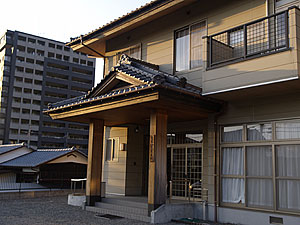
The Tsukushi branch building.
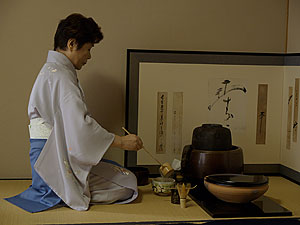
Preparing tea for a visitor.
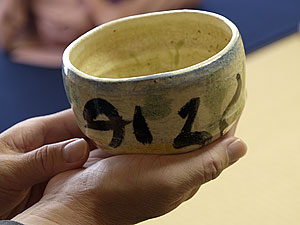
One of Onisaburo Deguchi’s early tea bowls.
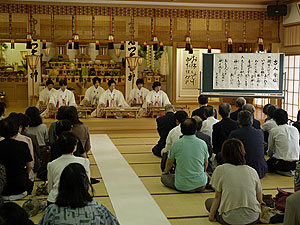
After the service, a sing-along with the yakumogoto ensemble.
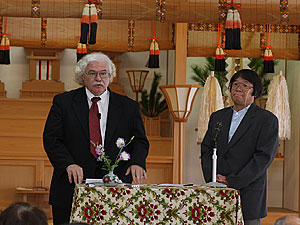
Bill Roberts and Hiromi Yano
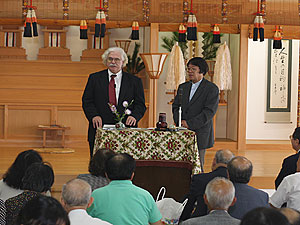
Bill Roberts speaks on the importance of the Middle East.
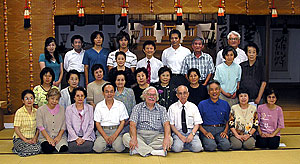
A group met the night before to discuss the Middle East.
New Contents Thu, May 20, 2010
- Oomoto participates in Sant’Egidio conference : Dialogue among religions and cultures : On divided island nation of Cyprus By Bill Roberts
- Photo Album : Portraits of three branches: Shoko, Tanegashima and Aomori By Bill Roberts
- Oomoto FAQ
- A Letter from Oomoto : Of mountains and myths By Bill Roberts
- Polyglot poem festival The Utamasturi is going international — what’s next? By Bill Roberts
- Ethics education program captures the spirit of Bankyo Dokon By Bill Roberts
- A Letter from Oomoto : A year’s worth of adventure in a summer of branch visits By Bill Roberts
- In Kumamoto, it’s all about water – and fire By Bill Roberts
- A speech by Nevada Taylor at the Kii Branch in Wakayama Prefecture on April 13, 2008.:An Encounter With Oomoto Through Aikido
- Utamatsuri, Poem Festival, in Tokyo(on April 17, 2008)
- A speech by Neil Ryan Walsh at the Kobe branch on Mar. 9th, 2008.:Planting the Seeds of the Soul
- Meeting with the Fifth Spiritual Leader of Oomoto, Madame Kurenai Deguchi by Neil Ryan Walsh
- A speech by Neil Ryan Walsh at the Nagoya branch on Feb. 17th, 2008.:The Japanese Arts beyond National Boundaries
- To the Oomoto branch in Nagoya: City of Eel and Toyota by Neil Ryan Walsh
- A Speech by Nissim Ben Shitrit, Ambassador of Israel on the occasion of the Oomoto Setsubun Grand Festival in Ayabe February 3rd, 2008 : Japan and Israel : Two Lands Balancing the Needs of Traditional Culture and Modern Life. r
- A permanent memorial to Onisaburo (A Speech at the Autumn Grand Festival , November 6, 2007 : )By James Parks Morton, Founder and Chair, Emeritus of The Interfaith Center of New York
- Israel, Palestine and the Power of Poetry(Oomoto believes small efforts can have lasting ripple effects on people and peace)By Bill Roberts
- “Something Great”(This genetics pioneer, a friend of Oomoto, offers a clue to the mystery of life)By Bill Roberts
- Kamishima Cleanup (Harima branch members regularly visit this sacred island to keep the shrine tidy)By Bill Roberts
- Kyotaro Deguchi was one of six recipients of the 2007 James Parks Morton Interfaith Award
What is Oomoto?
- What is Oomoto?
- Spirtual Centers
- Founders and Spiritual Leaders
- History
- Organization and activities
- Teachings and scriptures
- Art Works of Founders and Leaders
Opinions[Archive]
- Statement of regret for the outbreak of war against Iraq (March 20,2003)
- Jinrui Aizenkai dispatched the "Urgent Appeal for a World (Global) Crisis" on March 14.
Grappling with Bioethics[Archive]
- Oomoto’s support for abolishing the death penalty (12, June 2003)
- The Oomoto Foundation protests any birth of a human clone baby. (5, January 2003)
- OOMOTO'S VIEW REGARDING JAPAN’S PERMITION TO THE RESERCH OF HUMAN EMBRYONIC STEM CELLS (ES cells)(12, June 2000)
Vistor’s Review[Archive]
- A speech by Bill Roberts at the Oomoto branch in Hiroshima after its monthly service on March 18, 2007:Encounters with war and peace
- How Bankyo Dokon changed one life by Linda Macphee
- A speech by Bill Roberts at the Hokuriku (Kanazawa) branch on Dec. 3, 2006:Ritual and myth -an encounter with ‘divine madness’
- A speech by Bill Roberts at the Himeji Cultural Center on Feb. 25, 2007:Mesmerized by the Japanese Arts
- A speech by Bill Roberts at the Kobe branch on Feb. 11th, 2007.:There are just human tears and human joy
- A Speech on the occasion of the Oomoto Setsubun Grand Festival in Ayabe February 3rd, 2007 : Egypt's role in Middle East peace
- Keynote Speech for the 28th World Federation Japanese Religionists Conference for World Peace in Tokyo (at Kokugakuin University, Novermber 29, 2006):Vision for Peace in the Middle East By Dr. Munther S. Dajani, Professor Dean, Faculty of Arts, Al Quds University, Jerusalem
- A speech to the Kyoto branch:Spiritual adventures in researching Oomoto leaders
- A Speech at The Oomoto Foundation on Monday, November 6, 2006 : Jordan's role in Middle East By Samir Nouri, Ambassador of the Hashemite Kingdom of Jordan
- A letter from Oomoto:The Young People of Tottori
- A speech by Bill Roberts on the occasion of the dedication ceremony for the new shrine of Tottori Branch By Bill Roberts Oct. 8, 2006
- A speech by Bill Roberts at the Oomoto branch in Hiroshima after its monthly service on March 18, 2007:Encounters with war and peace
- How Bankyo Dokon changed one life by Linda Macphee
- A speech at Setsubun : A Portrait of Oomoto By Bill Roberts Feb. 3, 2006
- New Publication ! By Bill Roberts Feb. 3, 2006 A Portrait of Oomoto
you can read this book in html => http://www.jinruiaizenkai.jp/English/en-kolumno/en-bill/en-sugao/billbook1en.html
E-mail below to order brobert1@ix.netcom.com
Current Topics
- Prayer Offering and World Religious Forum II
- Living the art of dialogue
- Kyotaro Deguchi was one of six recipients of the 2007 James Parks Morton Interfaith Award
Books
Online Books
- Divine Signposts by Onisaburo DEGUCHI
- The Creation of Meaning by Hidemaru Deguchi
- Bankyo Dokon(Seventy years of Inter-Religious Activity at Oomoto)
- Nao Deguchi — A Biography of the Foundress of Oomoto
- The Great Onisaburo Deguchi published by Aiki News
- Bankyo Dokon Seventy Years of Inter-Religious Activity at Oomoto
- Insearch of Meaning
- Nao Deguchi A Biography of the Foundress of Oomoto
- A Portrait of Oomoto By Bill Roberts
Oomoto international Archive
- The History of Oomoto (Jan.– Mar. 1980 — Apr.– Jun. 1982)
- The Ancestors; Friends or Foes? (Apr.– Jun. 1987)
- Tsukinamisai; The Sabbath of Shinto (Jan.– Jun. 1983)
- The Poem Festival at Oomoto; An Ancient Rite Lives Again (Oct.– Dec. 1981)
- Purification of the Universe ; Oomoto's Setsubun Festival (Apr.– Jun. 1981)
Links
Flowers at Ten'on-kyo & Baisho-en (photographs)
Contact
All rights reserved : the Oomoto Foundation Produced by the Netinformational Commission
Since : Mar. 7.1998 Last Update : Thu, May 20, 2010
E-mail : webmaster@oomoto.or.jp
Top Page Nihongo Esperanto Português Roomazi



